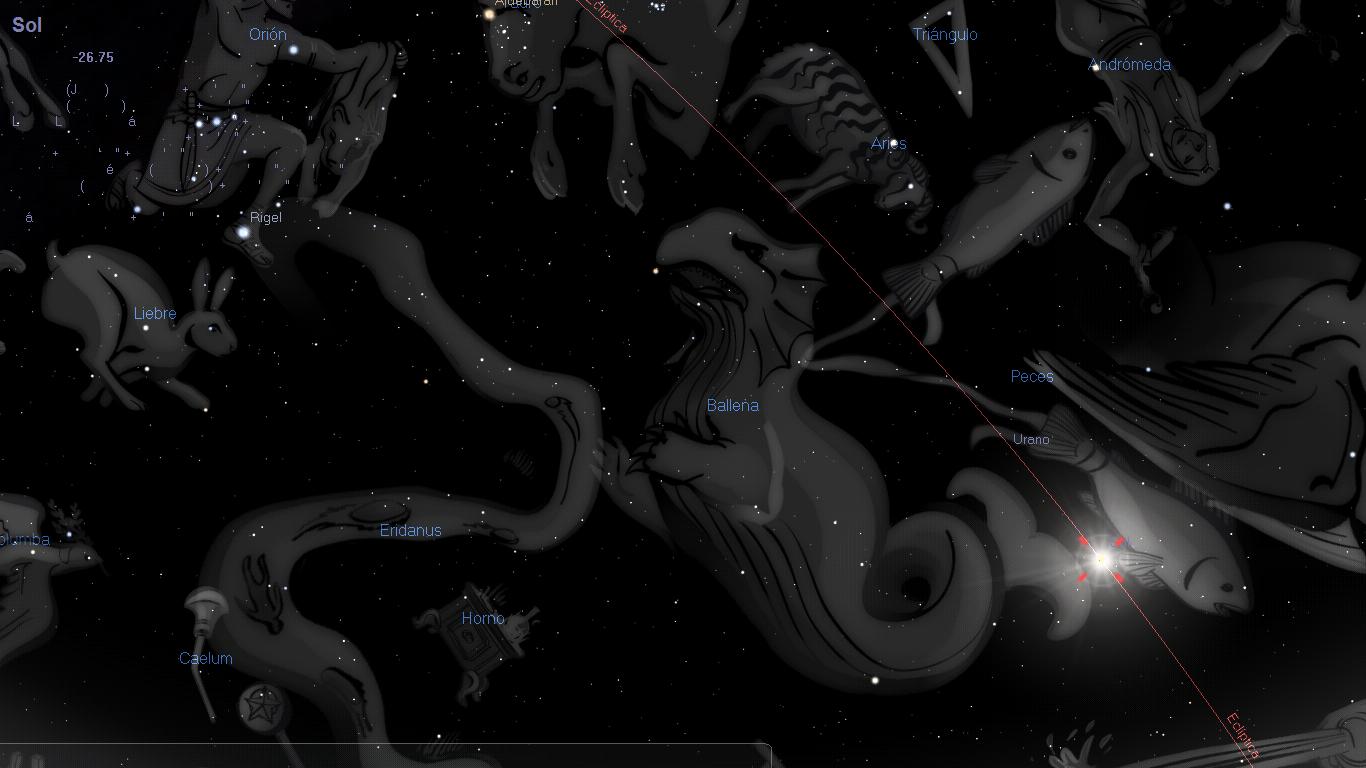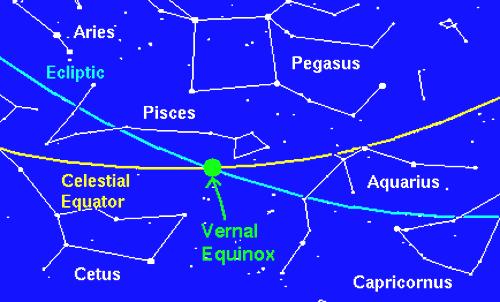|
Sidereal zodiac and tropical zodiac
By Krishna Wiuker
One
of the main differences between Vedic and western astrology
This past march
20th 2014 was the day of the equinox, which marks the beginning
of spring for the northern hemisphere and of fall for the
southern one.
The equinoxes are the days in which the two poles of the earth
are at the same distance from the Sun. The Sun is aligned
with the equatorial plane of the earth. This event happens
twice a year. Those are the moments when the day and night
have equal length.
In common western astrology, this is considered as the beginning
of Aries, meaning when the Sun supposedly aligns with the
beginning of the constellation of Aries.
But in fact, this is a misconception.
That DOESN’T
happen literally.
If we observe
the sky or through a basic astronomical calculation we can
see that at this time of the year the Sun is almost in the
beginning (6 degrees) of the constellation of Pisces, meaning,
that seen from the earth, the Sun is aligned with the constellation
of Pisces behind it. This is actually quite far from the beginning
of Aries, as we can see in the picture, which is a modern
astronomy planetarium simulator. We will see the Sun entering
the constellation of Aries only from April 14th.

In this picture, we can observe the Sun and the constellations
on the sky on March 20th 2014. The red line indicates the
ecliptic, the path of the Sun in the sky as seen from earth.
(This picture corresponds to the sky as seen from the northern
hemisphere. If you are in the south, you will see it all inverted,
upside down, right side left.)
That misunderstanding about the Sun’s constellation
placement happens because of a phenomena called precession
of the equinoxes. Due to the tilt of the earth axis, every
year when the equinox happens, it does 50.3” seconds
or arc earlier in the sky.
In ancient times, there was a time when the equinox did happen
at the beginning of Aries, and that was in the year 285 AD.
Since then, the equinox has been moving backwards in the zodiac
with a speed of one degree every 72 years approximately. Nowadays
the precession has gone about 24 degrees backwards and it
happens in the earlier portion of Pisces, aprox 6 degrees.
The type of zodiac that western astrology commonly uses is
called the “tropical” zodiac, because it is based
in the equinoxes, the seasons and the placement of the Sun
relative to the earth equator and to the parallels of the
tropic of cancer and Capricorn, and from there the confusion
arises, because the projection of the Sun into the earth on
those tropics has for long time not correspondence with the
constellations of the same names (cancer and Capricorn)
On the other hand, Vedic astrology has always considered the
precession and calculates the difference between the equinoxes
and the placement of the Sun and the rest of the planets in
relation to the stars and constellations in the sky.
That’s why the zodiac used by Vedic astrologers is called
the “sidereal” zodiac, the word sidereal coming
etymologically from the meaning “in reference to the
stars”.
This difference of degrees between the two zodiac systems
is not only applicable to the Sun sign, but also to the moon,
the ascendant and the rest of the planets. Doing that, the
birth chart is quite different.
Nevertheless, the tropical zodiac has its validity for certain
areas of astrology, no doubt, but it is inaccurate and misleading
in others. We have to understand the differences between these
two zodiacs systems and what each of them is representing.
The tropical zodiac is the proper one if we want to understand
the relation between the Sun and the earth at any time of
the year, and especially to determine the beginning and ending
of the seasons, which definitely have an influence on the
life on earth. Astrologically the tropical placement of Sun
and planets does have some influence in the personality and
psychology trends of an individual, more from the point of
view of the ego.
Even tough many vedic astrologers completely deny the use
of the tropical system, we can see that its use has some validity
to show certain dimensions of the influence of planets. The
division of the circumference of the ecliptic into 12 sections
can actually be done from different starting points of the
sky, and it will be helpful to understand different dimensions
of a birth chart. Even when we use the sidereal zodiac, we
could use the tropical one as a sort of a “house system”
when the first house always has a parallelism with Aries,
the second with Taurus, and so on.
Even in vedic astrology, the first house, whatever the sign
it is, has some characteristics of Aries and so on.
So in this way, if we take the equinox as a starting point
(equivalent to an alternative ascendant) we can divide the
rest of the sky into 12th equal sections and relate them with
Aries, Taurus, etcetera, even though those do not correspond
with the actual constellations of those names.
But, on the other hand, when we want to understand the influence
of the constellations on the way the planets manifest, the
use of the tropical zodiac can be inaccurate. We would commonly
make important astrological mistakes or at least it would
limit the precision of a chart interpretation and prediction
if we rely in the tropical signs alone.
For example, we cannot attribute characteristics of the constellation
of Aries to the Sun, and forget that in fact it is located
in front of the constellation of Pisces. Aries and Pisces
have totally different characteristics and energies and represent
very different things and dimensions of experience. The same
with the Moon, the ascendant and the rest of the planets.
It is very important to understand and analyze their Sidereal
placement.
If we want to know their actual placement in the sky, in reference
to the actual star constellations, we would have to subtract
about 24 degrees from their tropical placement.
According to Vedic astrology, the sidereal is the one that
relates to the Soul’s journey through the different
life times and the type of karma that it brings into this
world to be experienced, and also for accurate predictions
about future events.
Nevertheless, the tropical zodiac has its uses. Some astrologers
who studied and use both systems claim that the tropical one
is helpful to understand the personality and psychology of
an individual, but inaccurate at the time of making predictions
or timing of events and the vedic/sidereal astrologers are
very good at.
Even in classic vedic Jyotish scriptures, like for example
Surya Siddhanta, mentions the use of tropical zodiac to calculate
certain Sun influences, which re very important for the Vedic
life, like the ritus (seasons) and the Ayanas (uttarayana
and dakshinayana, the Day and night of the Devas, beginning
and ending of the northern or southern movement of the Sun
for 6 months). The Ayanas are very important in Muhurtha or
vedic electional astrology, especially for the performance
of some of the vedic rituals, building of Temples, yogic practices
and even for choosing the time of leaving the physical body!
There are still many Vedic astrologers, short of astronomical
understanding, that blindly hold to the use of sidereal zodiac
for the calculation of Ayanas.
There is a common widespread misuse of the sidereal zodiac
even by many Priest in India, when they celebrate the “makara
shankranti” of ingress of the Sun in the constellation
of Capricorn, (January 14th) as an indicator of the beginning
of the Uttaraayana (northern course of the Sun) when in fact
the Sun starts to move northwards from about December 21st,
which corresponds to the ingress into tropical Capricorn,
and not sidereal Capricorn.

Copyright © by
Jyotish 9graha, all rights reserved.
Contact us at jyotish@9graha.com
Content, graphics, and HTML
code are protected and may not be copied, reprinted, published,
translated, hosted, or otherwise distributed by any means
without explicit permission.
|


